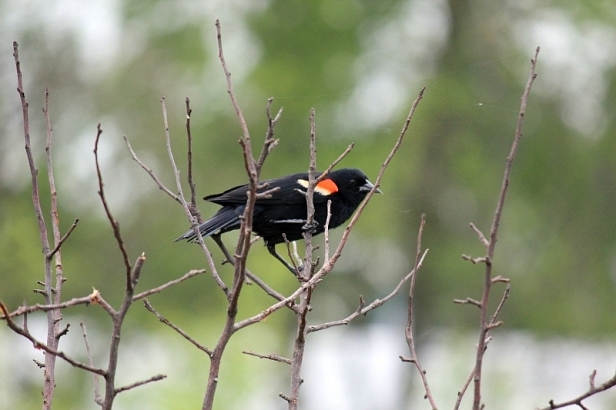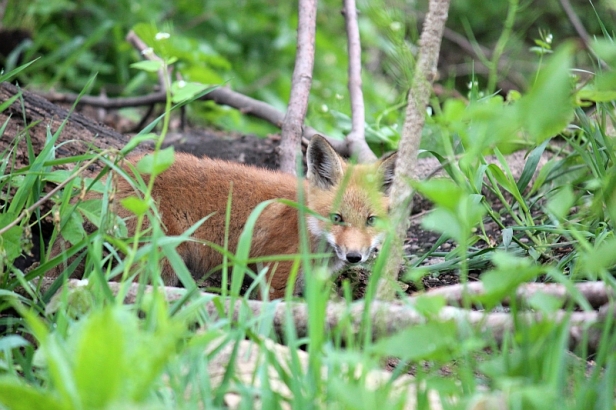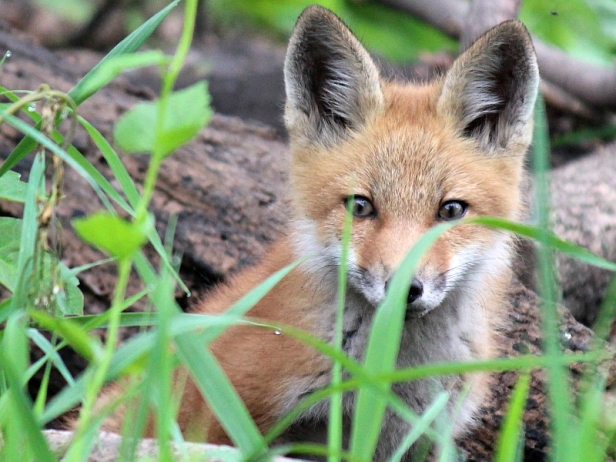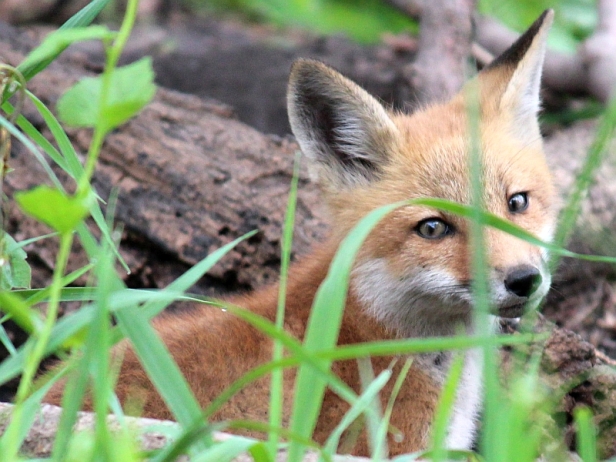Red Fox
This picture started it all.
“Have you seen the foxes?”
I paused in taking a picture of a Red-Winged Blackbird to talk to a lady out walking her two dogs. It was early May at Heritage Trail Metro Park, and I’m glad she asked!
For the last couple of years, she told me, a family of Red Foxes had a den out along the Heritage Trail, the miles-long paved greenway trail between Hilliard and Plain City that ran through the park I was at. The greenway had a decent amount of foot and bicycle traffic, and people had observed 4 young foxes (known as kits) at the den along the trail this spring. She described the details of where they were, and after thanking her, I set out to look for them.
Foxes! I hadn’t seen a fox since I was a teenager- and the one I did see was running across a field I had just stepped into from a patch of woods. I just assumed that foxes liked to keep themselves out of view. But I was about to learn differently in this particular case.
Red Foxes inhabit most of the Northern Hemisphere, making them the most widespread carnivore in the natural world. They typically eat small rodents, but will also eat many other things, including fruit and vegetables when necessary- or even whatever they scavenge from trash. Typically associated with the countryside, these animals have adapted well to suburban areas. Throughout history, they have been hunted for their pelts and even for sport. In mythology, they are frequently seen as cunning and resourceful figures, reflecting their hardy natures.
The greenway trail ran through agricultural country on the far west edge of Columbus and its suburbs. It was a pleasant area, perfect for foxes.
I approached the area where the fox den was located- near a log along the trail.
Sure enough, I could see the entrance to the den there. I looked carefully over the area along the trail, walking slowly.
A Catbird paused in its frantic squeaky singing to check me out. I walked back to the den, and saw something in the undergrowth.
A fox was there, near the den. It observed me as I held still, taking pictures. I saw it sniff the air as if smelling me.
As I got a better look at it, I realized it was one of the kits.
This little one is probably 2 to 3 months old- it has its red fur (when very young they are black or brown), its beautiful eyes are golden (at birth they are blue), and it has developed characteristic color patterns and guard hairs.
Female foxes have litters of between 2 to 12 kits in the spring. Juvenile foxes may grow up to strike out on their own if there is good territory in the area, or they may stay with their parents in a family group for some time, even helping mom and dad raise their next litter.
A fox’s bushy tail is helpful in keeping their balance, and also can be used for signaling other foxes, as well as making a warm face covering in cold winter weather when they are curled up.
What a handsome animal! And it wasn’t frightened of me- kits have little fear of people, though when they grow up they become wary of us.
Time for a good scratch. The kit lounged about, looking around, occasionally grooming or engaging in playful behavior. It stayed near the den in the undergrowth, and while it was aware of me perhaps 30 feet away, it wasn’t too worried about me.
When a person walked by with two dogs on a leash, the kit sniffed the air and looked intently at them, ears up- dogs and foxes aren’t terribly different, after all. I could see how people could easily miss this marvelous creature- who would be expecting to see something like this in the undergrowth near a paved trail in broad daylight?
Eventually, the kit moved away from the den into the undergrowth, perhaps looking for its family members, or for something to eat or to play with. I was very happy to get pictures of it. I’ll be checking out this den next spring to see if it’s still being used!
If you’d like to learn more about Red Foxes, The Fox Website has plenty of information for you.
















Lucky you, Karen, stumbling across the fox den. We saw a fox on our farm this past winter, but it evidently smelled the dogs and hasn’t come that close again.
WOW!!! I’ve seen foxes, and I’ve seen kits, I have even seen a few dog/fox hybrids, but I have never seen a kit that would hang around for some one to take that many photos of it. You made the most of it by getting some really terrific shots!
Fabulous — feel like I’m there discovering the kit myself.
On my way last Saturday to pick up my friends before we went birding, I was driving through a residential neighborhood and saw a fox cross the road right in front of me. It has been a long time since I’ve seen one.
What a wonderful sighting and great captures of this little fox!
Nothing cuter than a young animal learning about its world. Nice photos.
Tracy, this is great! I love foxes, we used to see them here all the time until they cut down the woods nearby for a mcMansion development. I miss them and your wonderful photos really captured the beautiful face and expression perfectly. Nice to know that they are flourishing somewhere. 🙂
What a cute kit! Thanks for sharing your find.
Great series of photos and narrative, Tracy. Wonderful images of the Foxes. As a side note, that barn photo is an excellent landscape image, too.
Great photos! You were very fortunate to be that close!
What a great experience, and superb photos!
Hi. You got some great photos. I love the ears of the kit. Last weekend we saw two foxes on the road near our summer place. They had a bird between them and had a terrible time trying to avoid us and stay together to share their prize. Jane
A most enjoyable post. Thank you.
Nice photos! We had a family of foxes around for a couple of years, but sad to say they have moved to a new home. I love walking trails like this one.
Aw so precious. Fox kits are so cute. Your photos are truly a rare treat. You must be in 7th heaven to have these. I would still be doing the ‘happy dance’ 🙂
We used to have a family of foxes living next door until the neighbors started moving in. I watched as the Mama would go away during the day and come back in the afternoon filthy dirty for a few days in a row. Shortly thereafter, we saw her toting her kits one at a time to their new home. We loved seeing the foxes, but are glad they moved to a hopefully safer place.
Excellent! What a rare opportunity, and how fortunate that you were there at the right time.
Great shots, you are so lucky to see and photograph this cute kit!
Hi, A friend of mine sent me some photos of some long haired foxes… I had never seen long haired foxes before… These photos of yours are great.
I tried ot post on twitter and on facebook…but something is a bit sticky tonight. I’ll try later.
Like so many other places, our bountiful fox residents have dwindled to only a few here in the heart land of America. Its quite sad not to see the wildlife we once had. Thank you for wonderful shots of this adorable kit.
Thanks for the comments, everyone! This post is a hard act to follow- it’s unusual I get such clear photos of cooperative wildlife 🙂
W.S….All I can say is…WOW…
How lucky! These are wonderful shots. 🙂
Oh, I envy you so much… what an incredible treat that was. 🙂